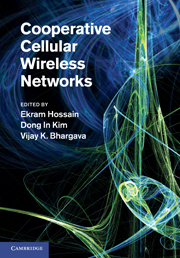Book contents
- Frontmatter
- Contents
- List of contributors
- Preface
- Part I Introduction
- Part II Cooperative base station techniques
- Part III Relay-based cooperative cellular wireless networks
- Part IV Game theoretic models for cooperative cellular wireless networks
- 13 Coalitional games for cooperative cellular wireless networks
- 14 Modeling malicious behavior in cooperative cellular wireless networks
- Part V Standardization activities
- Index
13 - Coalitional games for cooperative cellular wireless networks
from Part IV - Game theoretic models for cooperative cellular wireless networks
Published online by Cambridge University Press: 03 May 2011
- Frontmatter
- Contents
- List of contributors
- Preface
- Part I Introduction
- Part II Cooperative base station techniques
- Part III Relay-based cooperative cellular wireless networks
- Part IV Game theoretic models for cooperative cellular wireless networks
- 13 Coalitional games for cooperative cellular wireless networks
- 14 Modeling malicious behavior in cooperative cellular wireless networks
- Part V Standardization activities
- Index
Summary
Introduction
Cooperation among wireless nodes has attracted significant attention as a novel networking paradigm for future wireless cellular networks. It has been demonstrated that, by using cooperation at different layers (physical layer, multiple access channel (MAC) layer, network layer), the performance of wireless systems such as cellular networks can be significantly improved. In fact, cooperation can yield significant performance improvement in terms of reduced bit error rate (BER), improved throughput, efficient packet forwarding, reduced energy, and so on. In order to reap the benefits of cooperation, efficient and distributed cooperation strategies must be devised in future wireless networks. Designing such cooperation protocols encounters many challenges. On the one hand, any cooperation algorithm must take into account not only the gains but also the costs from cooperation which can both be challenging to model. On the other hand, the wireless network users tend to be selfish in nature and aim at improving their own performance. Therefore, giving incentives for these users to cooperate is another major challenge. Hence, there is a strong need to design cooperative strategies that can be implemented by the wireless nodes, in a distributed manner, while taking into account the selfish goals of each user as well as all the gains and losses from this cooperation.
This chapter describes analytical tools from game theory that can be used to model the cooperative behavior in wireless cellular networks.
- Type
- Chapter
- Information
- Cooperative Cellular Wireless Networks , pp. 347 - 381Publisher: Cambridge University PressPrint publication year: 2011
- 14
- Cited by



